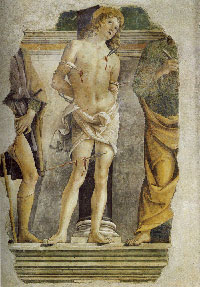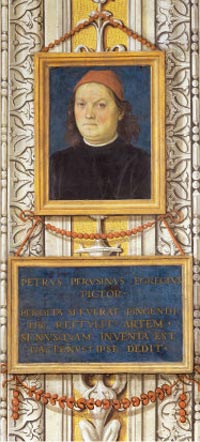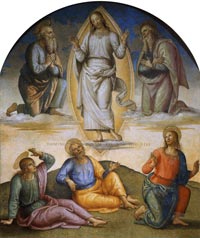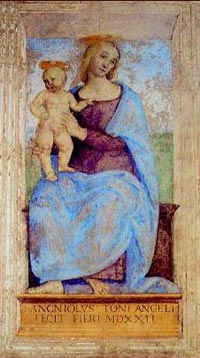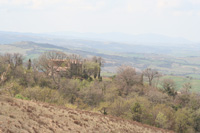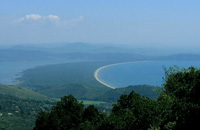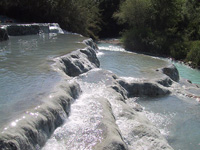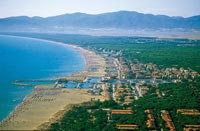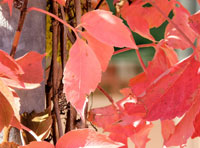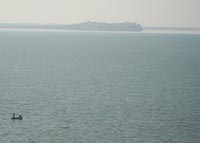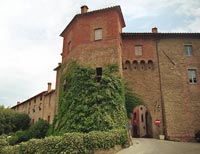 |
|
Pietro Perugino, St. Sebastian and pieces of figure of St. Rocco and St. Peter (detail), 1478, Chiesa di Santa Maria Assunta, Cerqueto |
|
Pietro Perugino | Saint Sebastian |
The earliest depiction of St. Sebastian is a mosaic from around 682. It shows an adult bearded man in court dress but contains no arrows. It wasn't until the Renaissance that he was first shown as a youth pierced by arrows. In 367 a basilica which was one of the seven chief churches of Rome was built over his grave. The present church was completed in 1611 by Scipio Cardinal Borghese. At the shrine of St Sebastian is a statue of the dying saint by Antonio Giorgetti, one of Bernini's pupils. It may have been made after a drawing by Bernini himself. |
Pietro Perugino | San Sebastiano tra i santi Rocco e Pietro |
| San Sebastiano tra i santi Rocco e Pietro è un affresco frammentario di Pietro Perugino, databile al 1478 e conservato nella chiesa di Santa Maria Assunta di Cerqueto, in provincia di Perugia. |
Descrizione e stile |
||
Su di un basamento all'antica in finto marmo, si erge la colonna a cui è legato san Sebastiano, il militare romano condannato per via della sua fede cristiana al martirio tramite crivellatura di frecce. Il soggetto, dalla metà del Quattrocento in poi, permetteva agli artisti di cimentarsi nella rappresentazione anatomica di un nudo secondo i canoni dell'arte classica, che ebbe un notevole successo. Per Perugino si tratta del primo esempio di tale soggetto, caratterizzato da una figura esile e languida soffusamente illuminata, che venne poi replicata in numerosi altri dipinti: se ne conoscono uno al National Museum di Stoccolma, uno frammentario all'Ermitage di San Pietroburgo, uno al Louvre (1490), con una derivazione al Museo d'Arte di São Paulo, uno nella chiesa di San Sebastiano a Panicale (1505) e uno nella chiesa di San Francesco al Prato a Perugia (1518). Il giovane martirizzato non esprime alcun dolore, ma un vaga maliconia nello sguardo trasognato, con un'elegante postura accuratamente bilanciata tra gli scarti a destra (della testa) e a sinistra (del gomito piegato, della gamba protesa in avanti). |
||
 |
||
Pietro Perugino, St. Sebastian and pieces of figure of St. Rocco and St. Peter (detail), 1478, Chiesa di Santa Maria Assunta, Cerqueto |
||
|
||
Pietro Perugino, San Sebastiano, 1495 circa, Louvre, Parigi |
||
San Sebastiano è un dipinto a olio su tavola di quercia (176x116 cm) di Pietro Perugino, databile al 1495 circa e conservato nel Museo del Louvre a Parigi. La tavola è forse quella indicata nell'inventario della collezione Barberini a Roma nel XVII secolo. Come noto tale collezione venne dispersa ed esportata all'estero nel XIX secolo. Il San Sebastiano venne acquistato dal Louvre nel 1896. Descrizione e stile Il martirio di san Sebastiano, militare romano condannato per via della sua fede cristiana alla crivellatura di frecce, avviene al di sotto di una loggia classica, con pilastri decorati da grottesche (precocemente viste dall'artista a Roma) e con richiami alla rovina dell'edificio (una volta e un pilastro rotti a sinistra), che ricordano la fine del mondo pagano in cui la scena è idealmente ambientata; oltre la transenna marmorea dello sfondo, dove converge il pavimento a riquadri scorciato in prospettiva, si apre un dolcissimo paesaggio di colline punteggiate da sottili alberelli, che sfuma delicatamente in lontananza per effetto della foschia. Il santo campeggia in primo piano al centro del dipinto, creando una composizione fortemente simmetrica. È legato a una colonna di porfido rosso e il suo corpo nudo ha un modellato di una bellezza ideale ispirata sicuramente alla statuaria antica, come il Doriforo di Policleto. A parte il sottile e semitrasparente perizoma, il santo è nudo, con lo sguardo rivolto languidamente al cielo secondo uno schema ormai ben consolidato nell'arte del pittore, conosciuto per la prima volta nell'affresco di San Sebastiano tra i santi Rocco e Pietro di Cerqueto, presso Perugia. In basso la tavola presenta l'iscrizione "SAGITTAE. TUAE.INFIXAE. SUNT. MICHI", dal Salmo 37. L'illuminazione è chiara e dolcemente soffusa, sia nel paesaggio, che schiarisce verso l'orizzonte secondo l'esempio fiammingo filtrato dai fiorentini, sia nel modellato del corpo, reso con un'attenzione anatomica di grande realismo. Esiste una versione pressoché identica dell'opera nel Museo d'Arte di San Paolo in Brasile, dove mancano solo l'iscrizione e le architetture in rovina, ritenuta generalmente una copia autografa dell'artista di una decina d'anni successiva. |
||
|
||
Martirio di san Sebastiano, 1505, affresco, Panicale, chiesa di San Sebastiano |
||
 |
||
Pietro Perugino, Martirio di san Sebastiano (dettaglio), 1505, affresco, Panicale, chiesa di San Sebastiano |
||
Il Martirio di san Sebastiano, conservato nella chiesa di San Sebastiano a Panicale, è un affresco databile al 1505. La Chiesa di S. Sebastiano, nota per la presenza dello straordinario affresco del Perugino dedicato al Martirio di S. Sebastiano (1505) restaurato alla fine degli anni ’80, capolavoro che colpisce per la trasparenza dei colori e la creazione di uno spazio che sembra infinito. Il paesaggio rappresentato sullo sfondo, con il lago e le dolci colline è molto simile a quello che si ammira appena fuori l’edificio. All’interno della stessa chiesa vi è custodito un affresco staccato, della Scuola del Perugino, una Madonna in trono con Bambino ed Angeli musicanti, probabilmente opera dello Spagna ed originariamnte appartenete alla Chiesa di s. Agostino (vedi alcune foto: foto1 - foto2 - foto3). Il martirio di san Sebastiano, militare romano condannato per via della sua fede cristiana alla crivellatura di frecce, avviene in una specie di piazzale porticato, con una serie di solenni archi all'antica sullo sfondo e un pavimento a riquadri in prospettiva, al centro del quale si trova un ampio basamento dove Sebastiano è legato a una colonna, mentre tutt'intorno, in bilanciate posizione simmetriche, quattro aguzzini stanno colpendolo con le frecce. In alto, sotto una sorta di timpano decorato da bassorilievi dipinti, si trova il Padre Eterno circondato da due angeli, da cherubini e serafini entro un nimbo luminoso, benedicente il santo che gli rivolge lo sguardo. Numerosi sono gli elementi tratti dall'architettura classica, anche se reinterpretati con fantasia. In lontananza, oltre gli archi, si distende un dolcissimo paesaggio che sfuma a perdita d'occhio secondo le leggi della prospettiva aerea. San Sebastiano è raffigurato in maniera ormai convenzionale, col corpo seminudo elegantemente bilanciato in una posa "a contrapposto", ispirata alla statuaria antica. Il movimento degli arcieri, con i due angeli che sembrano accorrere, è l'unico accenno di movimento nella scena che altrimenti risulta dominata da un senso di pacata tranquillità, alla ricerca di una forma idealmente perfetta. |
 Martirio di san Sebastiano, 1505, affresco, Panicale, chiesa di San Sebastiano |
|
|
||
 |
||
Pietro Perugino, Martirio di san Sebastiano (dettaglio), 1505, affresco, Panicale, chiesa di San Sebastiano |
||
[1] Pietro Perugino, born Pietro Vannucci, was an Italian Renaissance painter of the Umbrian school, who developed some of the qualities that found classic expression in the High Renaissance. Raphael was his most famous pupil. He was born Pietro Vannucci in Città della Pieve, Umbria, the son of Cristoforo Vannucci; his nickname characterizes him as from Perugia, the chief city of Umbria. Despite what stated by his biographer Giorgio Vasari, the Vannucci were one of the richest in the town.[1] His exact date of birth is not known, although, basing on his age at the death mentioned by Vasari and Giovanni Santi, it has been dated between 1446 and 1452.[1] He most likely began to study painting in Perugia, in local workshops such as those of Bartolomeo Caporali or Fiorenzo di Lorenzo.[1] The date of this first Florentine sojourn is unknown; some make it as early as 1466/1470, others push the date to 1479.[1] According to Vasari, he apprenticed in the workshop of Andrea del Verrocchio alongside Leonardo da Vinci, Domenico Ghirlandaio, Lorenzo di Credi, Filippino Lippi and others. He may have learned perspective from Piero della Francesca. In 1472 he must have completed his apprenticeship, for he was enrolled as a painter in the confraternity of St Luke. Perugino was one of the earliest Italian practitioners of oil painting. Some of his early works were extensive frescoes for the convent of the Ingessati fathers, destroyed during the siege of Florence; he produced for them also many cartoons, which they executed with brilliant effect in stained glass. A good specimen of his early style in tempera is the tondo (circular picture) in the Musée du Louvre of the Virgin and Child Enthroned between Saints. Perugino returned from Florence to Perugia, where his Florentine training showed in the Adoration of the Magi for the church of Santa Maria dei Servi of Perugia (c. 1476). In about 1480, he was called to Rome to fresco panels for the Sistine Chapel walls by Sixtus IV including Moses and Zipporah (often attributed to Luca Signorelli), the Baptism of Christ, and Delivery of the Keys. Pinturicchio accompanied Perugino to Rome, and was made his partner, receiving a third of the profits. He may have done some of the Zipporah subject. The Sistine frescoes were the major high Renaissance commission in Rome. The altar wall was also painted with the Assumption, the Nativity, and Moses in the Bulrushes. These works were later destroyed to make a space for Michelangelo's Last Judgement, Perugino, aged forty, left Rome after completion of the Sistine Chapel work in 1486, and by autumn was in Florence. Here he figured in a criminal court case. In July 1487 he and another Perugian painter named Aulista di Angelo were convicted, on their own confession, of having in December waylaid with staves someone (the name does not appear) in the streets near Pietro Maggiore. Perugino merely intended assault and battery, but Aulista meant to commit murder. The more illustrious culprit, guilty of the lesser offence, was fined ten gold florins, and the other was exiled for life. Between 1486 and 1499 Perugino worked chiefly in Florence, making one journey to Rome and several to Perugia, where he may have maintained a second studio. He had an established studio in Florence, and received a great number of commissions. His Pietà (1483–1493) in the Uffizi is an uncharacteristically stark work that avoids Perugino's sometimes too easy sentimental piety. In 1499 the guild of the cambio (money-changers or bankers) of Perugia asked him to decorate their audience-hall, the Sala delle Udienze del Collegio del Cambio. The humanist Francesco Maturanzio acted as his consultant. This extensive scheme, which may have been finished by 1500, comprised the painting of the vault with the seven planets and the signs of the zodiac (Perugino being responsible for the designs and his pupils most probably for the execution) and the representation on the walls of two sacred subjects: the Nativity and Transfiguration; in addition, the Eternal Father, the cardinal virtues of Justice, Prudence, Temperance and Fortitude, Cato as the emblem of wisdom, and numerous life-sized figures of classic worthies, prophets and sibyls figured in the program. On the mid-pilaster of the hall Perugino placed his own portrait in bust-form. It is probable that Raphael, who in boyhood, towards 1496, had been placed by his uncles under the tuition of Perugino, bore a hand in the work of the vaulting. Perugino was made one of the priors of Perugia in 1501. On one occasion Michelangelo told Perugino to his face that he was a bungler in art (goffo nell arte): Vannucci brought an action for defamation of character, unsuccessfully. Put on his mettle by this mortifying transaction, he produced the masterpiece of the Madonna and Saints for the Certosa of Pavia, now disassembled and scattered among museums: the only portion in the Certosa is God the Father with cherubim. An Annunciation has disappeared; three panels, the Virgin adoring the infant Christ, St. Michael and St. Raphael with Tobias are among the treasures of the National Gallery, London. This was succeeded in 1504-1507 by the Annunziata Altarpiece for the high altar of the Basilica dell'Annunziata in Florence, in which he replaced Filippino Lippi. The work was a failure, being accused of lack of innovation. Perugino lost his students; and towards 1506 he once more and finally abandoned Florence, going to Perugia, and thence in a year or two to Rome. Pope Julius II had summoned Perugino to paint the Stanza of the Incendio del Borgo in the Vatican City; but he soon preferred a younger competitor, Raphael, who had been trained by Perugino; and Vannucci, after painting the ceiling with figures of God the Father in different glories, in five medallion-subjects, retired from Rome to Perugia from 1512. Among his latest works, many of which decline into repetitious studio routine, one of the best is the extensive altarpiece (painted between 1512 and 1517) of the church of San Agostino in Perugia, also now dispersed. Perugino's last frescoes were painted for the church of the Madonna delle Lacrime in Trevi (1521, signed and dated), the monastery of Sant'Agnese in Perugia, and in 1522 for the church of Castello di Fortignano. Both series have disappeared from their places, the second being now in the Victoria and Albert Museum. He was still at Fontignano in 1523 when he died of the plague. Like other plague victims, he was hastily buried in an unconsecrated field, the precise spot now unknown. Vasari is the main source stating that Perugino had very little religion, and openly doubted the soul's immortality. Perugino in 1494 painted his own portrait, now in the Uffizi Gallery, and into this he introduced a scroll lettered Timete Deum. That an open disbeliever should inscribe himself with Timete Deum seems odd. The portrait in question shows a plump face, with small dark eyes, a short but well-cut nose, and sensuous lips; the neck is thick, the hair bushy and frizzled, and the general air imposing. The later portrait in the Cambio of Perugia shows the same face with traces of added years. Perugino died possessed of considerable property, leaving three sons. In the chapel of the Disciplinati of Città della Pieve is an Adoration of the Magi, a square of 6.5 m containing about thirty life-sized figures; this was executed, with scarcely credible celerity, from the 1st to 25 March (or thereabouts) in 1505, and must no doubt be in great part the work of Vannucci's pupils. In 1507, when the master's work had for years been in a course of decline and his performances were generally weak, he produced. nevertheless, one of his best; pictures — the Virgin between Saint Jerome and Saint Francis, how in the Palazzo Penna. In the church of S. Onofrio in Florence is a much lauded and much debated fresco of the Last Supper, a careful and blandly correct but uninspired work; it has been ascribed to Perugino by some connoisseurs, by others to Raphael; it may more probably be by some different pupil of the Umbrian master. Among his pupils were Raphael, upon whose early work Perugino's influence is most noticeable, and Giovanni di Pietro (lo Spagna).
[Fonte: PERUGINO: Meglio maestro d’Italia | www.correrenelverde.it]
|
|
|||
|
||||
 |
||||
Podere Santa Pia |
Pienza |
Podere Santa Pia |
||
Tombolo di Feniglia |
Saturnia |
Ombrone delta |
||
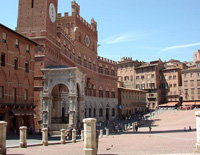 |
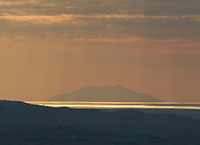 |
|||
Wines in southern Tuscany |
Siena, Palazzo Publicco |
Sunsets in Tuscany |
||
Umbria
|
||||
Panicale is a tiny village of Umbria, located between Città della Pieve and Perugia (33 km). It is a characteristic hamlet dominating the Lake Trasimeno from a rocky spur 431 m high. The town center still preserves the look of the ancient medieval castle with walls and two gates, the first one opens towards Florence and the second one towards Perugia.
|
||||
 |
||||
| Podere Santa Pia, a jewel in the heart of the Valle d'Ombrone, overlooks vineyards with views to the sea and Montecristo |
||||
This article incorporates material from the Wikipedia article Pietro Perugino published under the GNU Free Documentation License. |
||||
